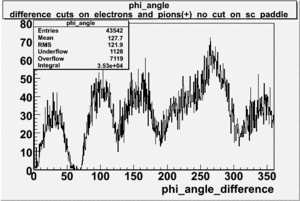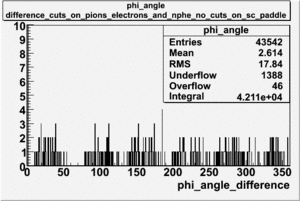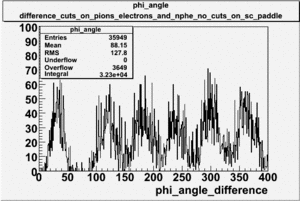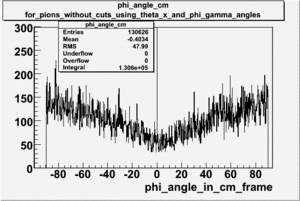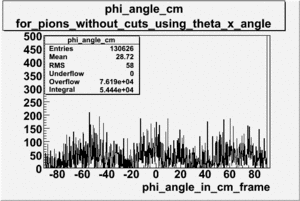Particle Identification
Quality Checks
EG1 run database
run summary
polarization info
Cuts
Calorimeter based cuts
The distributions below represent two types of cuts applied to improve the electron particle identification (PID) using a 4 GeV electron beam incident on an NH3 target. The electron calorimeter is segmented into an inner[math]EC_{inner}[/math] and an outer[math]EC_{outer}[/math] region. The total energy absorbed by the calorimeter system is recorded in the variable [math]EC_{tot}[/math]. The momentum ([math]P[/math]) is calculated using the reconstructed track and the known torus magnetic field. The distributions of [math]EC_{tot}[/math] and [math]EC_{inner}[/math] are shown below where both have been divided by the electron momentum and no cuts have been applied.
[math]EC_{tot}\gt 0.2*p[/math]
Without any cuts we have 181018 entries. After using the following cut [math]EC_{tot}\gt 0.2*p[/math] we are getting 127719 entries, which is about 70.55% of 181018.
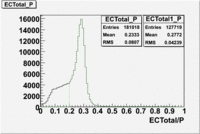
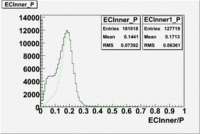
[math]EC_{inner}\gt 0.08*p[/math]
After the cut on the energy deposited into inner part of electron calorimeter, number of entries decreases by 22%.
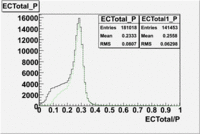
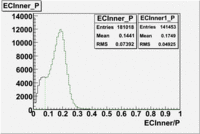
Both cuts [math] EC_{tot}\gt 0.2*p [/math] and [math] EC_{inner}\gt 0.08*p [/math]
In case of using the cuts of the total deposited energy and the energy deposited into inner calorimeter number of entries decreases ~36%
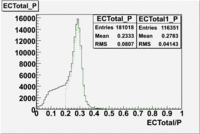
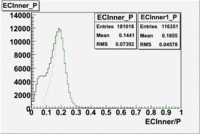
summary table
The "# of triggers" columns represents the number of events which generated a signal above threshold in the calorimeter and the scintillator. The expected # of events column represents the number of reconstructed events with tracks that also make it through the cuts defined in the table.
The semi-inclusive analysis will focus on the 4 GeV and 6 GeV data which have both inbending and outbending torus settings. Specifically runs 28074 - 28579 ( 4 GeV) and Runs 27356 - 27499 and 26874 - 27198 (6 GeV)
| Beam Energy |
Torus Current |
Begin Run |
End Run |
file used |
cuts |
|
|
# trig([math]10^6[/math]) |
expected # evts([math]10^6[/math]) |
p<3,[math]EC_{tot}\gt 0.2*p [/math],[math] EC_{inner}\gt 0.08*p[/math](%) |
p>3,[math]EC_{tot}\gt 0.24*p [/math],[math] EC_{inner}\gt 0.06*p[/math](%)
|
|
|
|
|
|
[math]EC_{tot}\gt 0.2*p[/math] |
[math]EC_{inner}\gt 0.08*p[/math] |
[math]EC_{tot}\gt 0.2*p [/math] and [math] EC_{inner}\gt 0.08*p[/math] |
|
|
|
|
| 1606 |
1500 |
25488 |
25559 |
dst25504_02.B00 |
64% |
49.5% |
78% |
60 |
3.2
|
| 1606 |
1946 |
25560 |
25605 |
|
|
44
|
| 1606 |
1500 |
25669 |
25732 |
dst25669_02.B00 |
64% |
49% |
78% |
226 |
10
|
| 1606 |
1500 |
25742 |
26221 |
dst25754_02.B00 |
21% |
11% |
24% |
3154 |
13.3
|
| 1606 |
-1500 |
26222 |
26359 |
dst26224_02.B00 |
4.6% |
3% |
6.6% |
703 |
13.1
|
| 1724 |
-1500 |
27644 |
27798 |
dst27649_02.B00 |
4.8% |
2.2% |
5.9% |
211 |
20
|
| 1724 |
1500 |
28512 |
28526 |
|
|
159
|
| 1724 |
-1500 |
28527 |
28532 |
|
|
93
|
| 2288 |
1500 |
27205 |
27351 |
dst27225_02.B00 |
20.2% |
13% |
25.6% |
1647 |
16.1
|
| 2562 |
-1500 |
27799 |
27924 |
dst27809_02.B00 |
5.7% |
4.6% |
8.6% |
1441 |
13.1
|
| 2562 |
-1500 |
27942 |
27995 |
dst27942_02.B00 |
6.1% |
4.4% |
8.9% |
841 |
32.3
|
| 2562 |
1500 |
28001 |
28069 |
dst28002_02.B00 |
27.8% |
13% |
29.6% |
1013 |
30.7
|
| 2792 |
-1500 |
27936 |
27941 |
dst27937_02.B00 |
6.7% |
5% |
9.9% |
69 |
20.6
|
| 3210 |
-2250 |
28549 |
28570 |
|
|
436
|
| 4239 |
2250 |
28074 |
28277 |
dst28075_02.B00 |
35.3% |
23.9% |
40.5% |
2278 |
19.6
|
| 4239 |
-2250 |
28280 |
28479 |
dst28281_02.B00 |
9.1% |
9.4% |
13.6% |
2620 |
15.2
|
| 4239 |
2250 |
28482 |
28494 |
|
|
7
|
| 4239 |
-2250 |
28500 |
28505 |
|
|
107
|
| 4239 |
2250 |
28506 |
28510 |
dst28509_02.B00 |
29.5% |
22% |
36% |
75 |
18.1
|
| 5627 |
2250 |
27356 |
27364 |
dst27358_02.B00 |
33.2% |
27.8% |
41.3% |
56 |
19.4 |
44.6 |
40.1
|
| 5627 |
-2250 |
27366 |
27380 |
dst27368_02.B00 |
12.6% |
14.8% |
19.5% |
130 |
13.6 |
25.3 |
8.8
|
| 5627 |
2250 |
27386 |
27499 |
dst27388_02.B00 |
33.4% |
27.8% |
41.4% |
1210 |
20.2 |
44.8 |
40.1
|
| 5627 |
965 |
27502 |
27617 |
|
|
493
|
| 5735 |
-2250 |
26874 |
27068 |
dst26904_02.B00 |
13% |
15% |
20% |
1709 |
19.9 |
25.6 |
9.1
|
| 5735 |
2250 |
27069 |
27198 |
dst27070_02.B00 |
33.3% |
28.8% |
42.2% |
1509 |
15 |
46 |
40.2
|
| 5764 |
-2250 |
26468 |
26722 |
dst26489_02.B00 |
12.2% |
14.4% |
19.1% |
1189 |
10 |
24.6 |
9.3
|
| 5764 |
0 |
26723 |
26775 |
|
|
268
|
| 5764 |
-2250 |
26776 |
26851 |
dst26779_02.B00 |
13.5% |
15.5% |
20.5% |
662 |
15.9 |
26.4 |
9.2
|
Cut on the number of photoelectrons
In this case is used a cut on the number of photoelectrons, which is [math]nphe\gt 2.5[/math]. The plots below show the
effect of the number of photoelectrons cuts on the Cerenkov distribution. We see that after using cut the number of entries decreases ~40.7%
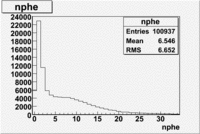
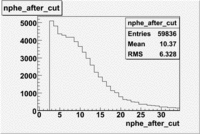
Used cuts [math]EC_{tot}\gt 0.24p[/math] and [math]EC_{inner}\gt 0.06p[/math]
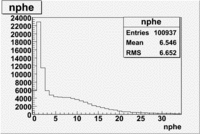
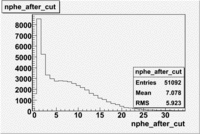
Used file dst28181_03(energy 4.2GeV). In this case was applied cuts on the polar angle([math]15\lt \theta\lt 20[/math]) and momentum([math]2.2\lt P\lt 2.6[/math]). Number of entries decreased by 96%(?????????????/)
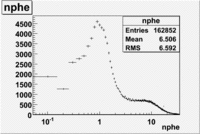
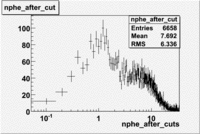
OSIPENKO cuts
Plot of [math]EC_{tot}/p[/math] vs [math]EC_{inner}/p[/math]
In this case is used file dst27070(Energy 5.735 GeV and Torus 2250) and are applied the following EC cuts: For ECtotal - [math]EC_{tot}\gt 0.2p[/math], for EC inner - [math]EC_{inner}\gt 0.08p[/math].
P<3
After using above cuts the number of entries decreases ~46%
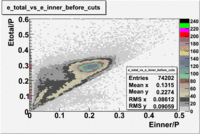
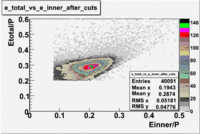
0.5<P<1
The number of entries decreased by ~51.8%
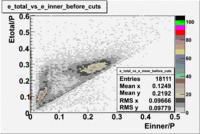
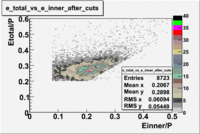
1<P<1.5
The number of entries decreased approximately by 47.8%
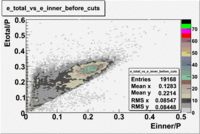
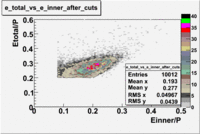
1.5<P<2
In this case the number of entries decreased by 46.1%
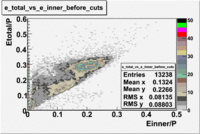
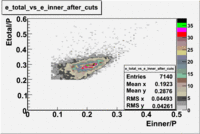
2<P<2.5
In this case the number of entries decreased by 38%
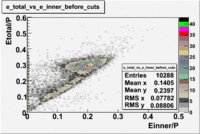
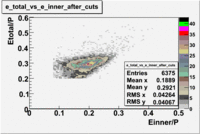
P>3
Used file dst27070(Energy 5.735 GeV and Torus 2250) and are applied the following EC cuts: For ECtotal - [math]EC_{tot}\gt 0.24p[/math], for EC inner - [math]EC_{inner}\gt 0.06p[/math].
The number of entries decreased by~40.2%
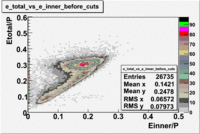
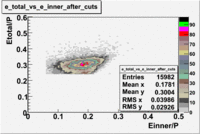
Plot of EC_tot/P vs nphe for Electrons
Used file dst27070(Energy 5.735 GeV and Torus 2250)
p<3 GeV
The graphs below represents all electron candidates having a momentum smaller than 3 GeV. Negatively charged pions are the most likely particle to be misidentified as an electrons by the tracking software. A negatively charged pion having a momentum of 3 GeV would generate less than ?? photons in the cerenkov counter. As a result the electron candidates which [math]n_{pe} \lt 1.xx [/math] are thought to be misidentified pions. The images which follow represent the effects of several cuts made for the purpose of removing misidentified particles.
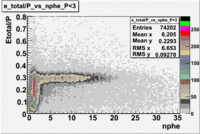
- chi_sqr for pions
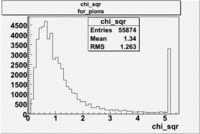
- [math]\pi[/math]_Momentum_vs_Number_of_Photons for pions([math]\pi[/math])
Used file:27095_05.B00(energy=5.735GeV and torus=2250), everything is done for [math]\pi^-[/math]
p<3 GeV and [math]EC_{inner}\gt 0.08p[/math]
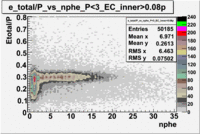
p<3 GeV, [math]EC_{inner}\gt 0.08p[/math] and [math]EC_{tot}\gt 0.2p[/math]
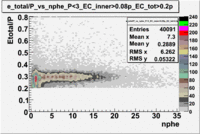
p<3 GeV, [math]EC_{inner}\gt 0.08p[/math], [math]EC_{tot}\gt 0.2p[/math] and nphe>2.5
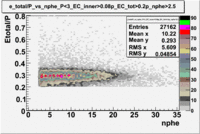
Plot of EC_total vs EC_inner
In this case file dst28181_03.B00 was used(Energy 4.2 GeV and Torus +2250).
The following cuts were applied:[math]EC_{inner}\gt 0.005[/math], [math]EC_{tot}\gt 0.2*p[/math], ec_chi_sqr<0.1 and nphe>3.
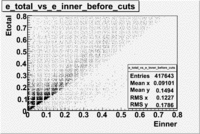
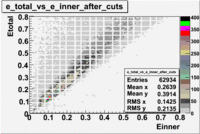
Raster and vertex correction
A raster calibration and a cut on the vertex distribution was made in order to select electrons from the polarized target, also the ones scattered from other materials in the beam path. A plot of the uncorrected vertex distribution is presented below for dst27070_02.B00 file(energy=5.7GeV Torus=2250)
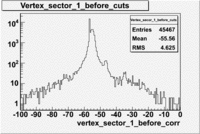
Pion
Summary Table
Josh's Pion cuts code
| Beam Energy |
Torus Current |
Begin Run |
End Run |
file used |
# trig([math]10^6[/math]) |
expected # evts([math]10^6[/math]) |
p>3,[math]EC_{tot}\lt 0.2*p [/math],[math] EC_{inner}\lt 0.08*p[/math](%) |
p<3,[math]EC_{tot}\lt 0.24*p [/math],[math] EC_{inner}\lt 0.06*p[/math](%)
|
|
|
|
|
|
|
|
|
|
| 1606 |
1500 |
25488 |
25559 |
dst25504_02.B00 |
60 |
3.2
|
| 1606 |
1500 |
25669 |
25732 |
dst25669_02.B00 |
226 |
10
|
| 1606 |
1500 |
25742 |
26221 |
dst25754_02.B00 |
3154 |
13.3
|
| 1606 |
-1500 |
26222 |
26359 |
dst26224_02.B00 |
703 |
13.1
|
| 1724 |
-1500 |
27644 |
27798 |
dst27649_02.B00 |
211 |
20
|
| 2288 |
1500 |
27205 |
27351 |
dst27225_02.B00 |
1647 |
16.1
|
| 2562 |
-1500 |
27799 |
27924 |
dst27809_02.B00 |
1441 |
13.1
|
| 2562 |
-1500 |
27942 |
27995 |
dst27942_02.B00 |
841 |
32.3
|
| 2562 |
1500 |
28001 |
28069 |
dst28002_02.B00 |
1013 |
30.7
|
| 2792 |
-1500 |
27936 |
27941 |
dst27937_02.B00 |
69 |
20.6
|
| 4239 |
2250 |
28074 |
28277 |
dst28075_02.B00 |
2278 |
19.6
|
| 4239 |
-2250 |
28280 |
28479 |
dst28281_02.B00 |
2620 |
15.2
|
| 4239 |
2250 |
28506 |
28510 |
dst28509_02.B00 |
75 |
18.1
|
| 5627 |
2250 |
27356 |
27364 |
dst27358_02.B00 |
56 |
19.4 |
36.1 |
31.5
|
| 5627 |
-2250 |
27366 |
27380 |
dst27368_02.B00 |
130 |
13.6 |
25 |
43.8
|
| 5627 |
2250 |
27386 |
27499 |
dst27388_02.B00 |
1210 |
20.2 |
39.8 |
32.4
|
| 5735 |
-2250 |
26874 |
27068 |
dst26904_02.B00 |
1709 |
19.9 |
22.5 |
46.4
|
| 5735 |
2250 |
27069 |
27198 |
dst27070_02.B00 |
1509 |
15 |
34.6 |
32.9
|
| 5764 |
-2250 |
26468 |
26722 |
dst26489_02.B00 |
1189 |
10 |
25.2 |
44.3
|
| 5764 |
-2250 |
26776 |
26851 |
dst26779_02.B00 |
662 |
15.9 |
21.3 |
44
|
Table for Pions
I used the pion id code(both subroutines):
Josh's Pion cuts code
| Beam Energy |
Torus Current |
Begin Run |
End Run |
file used |
events remaining after cuts |
|
# trig([math]10^6[/math]) |
expected # evts([math]10^6[/math])
|
|
|
|
|
|
first(%) |
second(%) |
|
|
| 1606 |
1500 |
25488 |
25559 |
dst25504_02.B00 |
96.8 |
99 |
60 |
3.2
|
| 1606 |
1500 |
25669 |
25732 |
dst25669_02.B00 |
98.1 |
98.9 |
226 |
10
|
| 1606 |
1500 |
25742 |
26221 |
dst25754_02.B00 |
13.4 |
22.8 |
3154 |
13.3
|
| 1606 |
-1500 |
26222 |
26359 |
dst26224_02.B00 |
11.3 |
15.3 |
703 |
13.1
|
| 1724 |
-1500 |
27644 |
27798 |
dst27649_02.B00 |
15.3 |
18.7 |
211 |
20
|
| 2288 |
1500 |
27205 |
27351 |
dst27225_02.B00 |
16.4 |
18.9 |
1647 |
16.1
|
| 2562 |
-1500 |
27799 |
27924 |
dst27809_02.B00 |
11.1 |
14.2 |
1441 |
13.1
|
| 2562 |
-1500 |
27942 |
27995 |
dst27942_02.B00 |
11.1 |
14.2 |
841 |
32.3
|
| 2562 |
1500 |
28001 |
28069 |
dst28002_02.B00 |
22.4 |
23.1 |
1013 |
30.7
|
| 2792 |
-1500 |
27936 |
27941 |
dst27937_02.B00 |
12.3 |
15.4 |
69 |
20.6
|
| 4239 |
2250 |
28074 |
28277 |
dst28075_02.B00 |
16.7 |
14.3 |
2278 |
19.6
|
| 4239 |
-2250 |
28280 |
28479 |
dst28281_02.B00 |
10.4 |
12.6 |
2620 |
15.2
|
| 4239 |
2250 |
28506 |
28510 |
dst28509_02.B00 |
% |
% |
75 |
18.1
|
| 5627 |
2250 |
27356 |
27364 |
dst27358_02.B00 |
40.5 |
40.8 |
56 |
19.4
|
| 5627 |
-2250 |
27366 |
27380 |
dst27368_02.B00 |
9.7 |
12.7 |
130 |
13.6
|
| 5627 |
2250 |
27386 |
27499 |
dst27388_02.B00 |
14.1 |
15.5 |
1210 |
20.2
|
| 5735 |
-2250 |
26874 |
27068 |
dst26904_02.B00 |
12.1 |
14.5 |
1709 |
19.9
|
| 5735 |
2250 |
27069 |
27198 |
dst27070_02.B00 |
19.5 |
22.9 |
1509 |
15
|
| 5764 |
-2250 |
26468 |
26722 |
dst26489_02.B00 |
9.6 |
13.3 |
1189 |
10
|
| 5764 |
-2250 |
26776 |
26851 |
dst26779_02.B00 |
10.3 |
13.9 |
662 |
15.9
|
Plot of EC_tot/P vs nphe for Pions
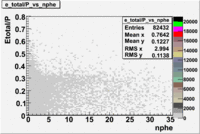
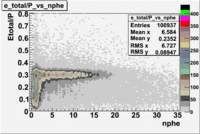
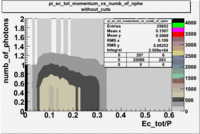
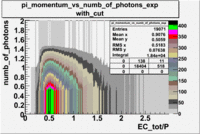
Quality Checks
Run Summary Table
The table below uses a characteristic DST file to try and estimate the sample size for a semi-inclusive analysis of pion electroproduction. The column marked "cuts" below indicates the number of events kept when the standard EC based electron identification cuts, described above, are used: [math]EC_{tot}\gt 0.2*p [/math] and
[math] EC_{inner}\gt 0.08*p[/math]. The next step will be to compare unpolarized pion production rates in order to evaluate the CLAS detectors efficiencies for measuring charged pions with different torus polarities. The question is whether you get the same rates for negatively charged pions in one torus polarity to positively charged pions using the opposite torus polarity.
| Beam Energy |
Torus Current |
Target |
Begin Run |
End Run |
file used |
# trig([math]10^6[/math]) |
events remaining after [math]e^-[/math] cuts(%) |
expected # evts([math]10^6[/math]) |
events remaining after [math]e^-[/math] and [math]\pi^+[/math] cuts(%) |
expected # evts([math]10^6[/math]) |
events remaining after [math]e^-[/math] and [math]\pi^-[/math] cuts(%) |
expected # evts([math]10^6[/math])
|
| 4239 |
2250 |
NH3 |
28205 |
28277 |
/cache/mss/home/nguler/dst/dst28205_05.B00 |
1108.72 |
60.8 |
674.1 |
8.3 |
92.02 |
3.24 |
35.92
|
|
|
ND3 |
28074 |
28190 |
/cache/mss/home/nguler/dst/dst28187_05.B00 |
1117.87 |
59.6 |
666.25 |
7.99 |
89.32 |
3.3 |
36.9
|
|
-2250 |
NH3 |
28407 |
28479 |
/cache/mss/home/nguler/dst/dst28409_05.B00 |
1013.57 |
24.2 |
245.28 |
0.12 |
1.22 |
0 |
0
|
|
|
ND3 |
28278 |
28403 |
/cache/mss/home/nguler/dst/dst28400_05.B00 |
1556.04 |
23.9 |
371.89 |
0.02 |
0.31 |
0.05 |
0.51
|
| 5735 |
2250 |
NH3 |
27074 |
27195 |
/cache/mss/home/nguler/dst/dst27095_05.B00 |
1442.25 |
57.7 |
832.18 |
9.3 |
134.13 |
3.8 |
59.13
|
|
|
ND3 |
27116 |
27170 |
/cache/mss/home/nguler/dst/dst27141_05.B00 |
624.55 |
59.1 |
369.10 |
9.53 |
59.52 |
3.9 |
24.36
|
|
-2250 |
NH3 |
26911 |
27015 |
/cache/mss/home/nguler/dst/dst26988.B00 |
900.93 |
80.7 |
727.05 |
7.14 |
64.33 |
9.9 |
89.19
|
|
|
ND3 |
27022 |
27068 |
/cache/mss/home/nguler/dst/dst27055_05.B00 |
711.53 |
80 |
569.22 |
6.97 |
49.59 |
10.1 |
71.86
|
Rates
Unpolarized Pion electroproduction
Rates from other experiments in our Kinematic range
Center of Mass Frame Transformation
We have proton and electron. In the Lab frame electron is moving along the x-axis with momentum ;[math]\vec{p_e}[/math] and proton is at rest. The 4-vectors are:
- Lab Frame
- [math]P_e=[/math]([math]E_e[/math],[math]p_e[/math],0,0) and for proton :[math]P_p=[/math]([math]m_p[/math],0,0,0)
- CM Frame
- :[math]{P_e}^{\prime}=[/math]([math]{E_e}^{\prime}[/math],[math]{p_e}^{\prime}[/math],[math]0[/math],[math]0[/math]) and for proton :[math]{P_p}^{\prime}=[/math]([math]{E_p}^{\prime}[/math],[math]{p_p}^{\prime}[/math],[math]0[/math],[math]0[/math])
- Find [math] \beta_{CM} [/math] such that [math]P_{tot}^{CM}=0 =p_e^{\prime} + {p_p}^{\prime}[/math]
- [math]\left ( \begin{matrix} {E_e}^{\prime} \\ p_e^{\prime} \\ 0 \\ 0 \end{matrix} \right )= \left [ \begin{matrix} \gamma & -\gamma \beta & 0 & 0 \\ -\gamma \beta & \gamma &0 &0 \\ 0 &0 &1 &0 \\ 0 &0 &0 & 1 \end{matrix} \right ] \left ( \begin{matrix} E_e \\ p_e \\ 0 \\ 0 \end{matrix} \right )[/math]
- [math]\left ( \begin{matrix} {E_p}^{\prime} \\ p_p^{\prime} \\ 0 \\ 0 \end{matrix} \right )= \left [ \begin{matrix} \gamma & -\gamma \beta & 0 & 0 \\ -\gamma \beta & \gamma &0 &0 \\ 0 &0 &1 &0 \\ 0 &0 &0 &1\end{matrix} \right ] \left ( \begin{matrix} m_p \\ 0 \\ 0 \\ 0 \end{matrix} \right )[/math]
Using the last two equations we will get the following for x component:
- [math]{p_e}^{\prime}=-\gamma_{cm}(\beta_{cm} E_e-p_e)[/math]
- [math]p_p^{\prime} = - \gamma_{cm} \beta_{cm} m_p[/math]
- [math] \gamma_{cm}(p_e - \beta_{cm} E_e)= \gamma_{cm} \beta_{cm} m_p [/math]
- [math]\beta_{cm} = \frac {p_e}{m_p + E_e}[/math]
Example of the Missing Mass Calculation for the following reaction [math]e^- p^+ \rightarrow (e^-)^{\prime} \pi^{-} X [/math]
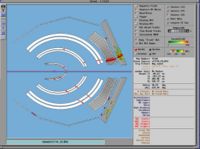
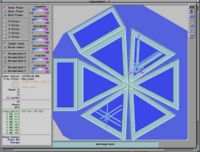
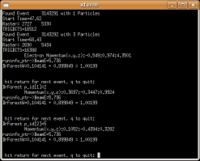
- [math]p_e = 5.736 Gev \sim E_e[/math] : electron mass is neglibible
- [math]m_p = 0.938 GeV[/math] : Mass of a proton
- [math]\beta_{cm} = \frac{5.736}{6.674} = 0.859 \lt 1[/math]
- [math]\gamma_{cm} = \frac{1}{\sqrt{1 - \beta_{cm}^2}} = \frac{1}{\sqrt{1 - 0.859^2}} = 1.9532[/math]
- [math]\left ( \begin{matrix} {E_e}^{\prime} \\ p_{ex}^{\prime} \\ p_{ey}^{\prime} \\ p_{ez}^{\prime} \end{matrix} \right )= \left [ \begin{matrix} \gamma_{cm} & 0 & 0 & -\gamma_{cm} \beta_{cm} \\ 0 & 1 &0 &0 \\ 0 &0 &1 &0 \\ -\gamma_{cm} \beta_{cm} &0 &0 &\gamma_{cm}\end{matrix} \right ] \left ( \begin{matrix} E_e=4.4915 \\ -0.549 \\ 0.974 \\ 4.3501 \end{matrix} \right )[/math]
- [math]\left ( \begin{matrix} {E_p}^{\prime} \\ p_{px}^{\prime} \\ p_{py}^{\prime} \\ p_{pz}^{\prime} \end{matrix} \right )= \left [ \begin{matrix} \gamma_{cm} & 0 & 0 & -\gamma_{cm} \beta_{cm} \\ 0 & 1 &0 &0 \\ 0 &0 &1 &0 \\ -\gamma_{cm} \beta_{cm} &0 &0 & \gamma_{cm} \end{matrix} \right ] \left ( \begin{matrix} E_p = 1.4563 \\ 0.3697 \\ -0.3447 \\ 0.9924 \end{matrix} \right )[/math]
- [math]\left ( \begin{matrix} {E_{\pi^-}}^{\prime} \\ p_{\pi^- x}^{\prime} \\ p_{{\pi^-} y}^{\prime} \\ p_{{\pi^-} z}^{\prime} \end{matrix} \right )= \left [ \begin{matrix} \gamma_{cm} & 0 & 0 & -\gamma_{cm} \beta_{cm} \\ 0 & 1 &0 &0 \\ 0 &0 &1 &0 \\ -\gamma_{cm} \beta_{cm} &0 &0 & \gamma_{cm} \end{matrix} \right ] \left ( \begin{matrix} E_{\pi^-} = 0.5757 \\ 0.1052 \\ -0.4394 \\ 0.3282 \end{matrix} \right )[/math]
- Electron
- [math]\left ( \begin{matrix} {E_e}^{\prime} \\ p_{ex}^{\prime} \\ p_{ey}^{\prime} \\ p_{ez}^{\prime} \end{matrix} \right )= \left ( \begin{matrix} 4.4915 \gamma_{cm} - 4.3501 \gamma_{cm} \beta_{cm} \\ -0.549 \\ 0.974 \\ -4.4915 \gamma_{cm} \beta_{cm} + 4.3501 \gamma_{cm} \end{matrix} \right ) = \left ( \begin{matrix} 1.4742 \\ -0.549 \\ 0.974 \\ 0.96078 \end{matrix} \right )[/math]
- Proton
- [math]\left ( \begin{matrix} {E_p}^{\prime} \\ p_{px}^{\prime} \\ p_{py}^{\prime} \\ p_{pz}^{\prime} \end{matrix} \right )= \left ( \begin{matrix} 1.4563\gamma_{cm} - 0.9924 \gamma_{cm} \beta_{cm} \\ 0.3697 \\ -0.3447 \\-1.4563 \gamma_{cm} \beta_{cm} + 0.9924\gamma_{cm} \end{matrix} \right ) = \left ( \begin{matrix} 1.17939 \\ 0.3697 \\ -0.3447 \\ -0.505023 \end{matrix} \right )[/math]
- [math]\pi^-[/math]
- [math]\left ( \begin{matrix} {E_{\pi^-}}^{\prime} \\ p_{\pi^- x}^{\prime} \\ p_{{\pi^-} y}^{\prime} \\ p_{{\pi^-} z}^{\prime} \end{matrix} \right )= \left ( \begin{matrix} 0.5757\gamma_{cm} - 0.3282 \gamma_{cm} \beta_{cm} \\ 0.1052 \\ -0.4394 \\ -0.5757 \gamma_{cm} \beta_{cm} + 0.3282\gamma_{cm} \end{matrix} \right ) = \left ( \begin{matrix} 0.5738 \\ 0.1052 \\ -0.4394 \\ -0.324868 \end{matrix} \right )[/math]
[math]\vec {P_{tot}}^{\prime} = (p_{ex}^{\prime} + p_{px}^{\prime} + p_{\pi^-x}^{\prime})\hat{x} + (p_{ey}^{\prime} + p_{py}^{\prime} + p_{\pi^-y}^{\prime})\hat{y} + (p_{ez}^{\prime} + p_{pz}^{\prime} + p_{\pi^-z}^{\prime})\hat{z} = - 0.0741 \hat{x} + 0.1899 \hat{y} + 0.13 \hat{z} [/math]
- Missing Mass
- Conservation of the 4-momentum gives us following
[math](P_e)^\mu + (P_p)^\mu = ({P_e}^{\prime})^\mu + ({P_X}^{\prime})^\mu + ({P_{\pi^-}}^{\prime})^\mu[/math]
[math](P_e)_\mu + (P_p)_\mu = ({P_e}^{\prime})_\mu + ({P_X}^{\prime})_\mu + ({P_{\pi^-}}^{\prime})_\mu[/math]
- Solving it for the final proton state
[math]{M_x}^2 = ({P_X}^{\prime})_\mu({P_X}^{\prime})^\mu = [(P_e)_\mu + (P_p)_\mu - ({P_e}^{\prime})_\mu - ({P_{\pi^-}}^{\prime})_\mu][(P_e)^\mu + (P_p)^\mu - ({P_e}^{\prime})^\mu - ({P_{\pi^-}}^{\prime})^\mu][/math]
- In our case 4-vectors for particles are
[math](P_e)_\mu = ( 5.736, 0, 0, 5.736 GeV)[/math]
[math](P_p)_\mu = (m_p, 0, 0, 0)[/math]
[math]({P_e}^{\prime})_\mu = (4.4914861, -0.549, 0.974, 4.3501 )[/math]
[math]({P_{\pi^-}}^{\prime})_\mu = (0.575721, 0.1052, -0.4394, 0.3282)[/math]
- Plug and chug
[math]{M_x}^2 = [( 5.736, 0, 0, 5.736 GeV) + ( m_p, 0, 0, 0 ) - (4.4914861, -0.549, 0.974, 4.3501 ) - (0.575721, 0.1052, -0.4394, 0.3282)[/math]] [[math]\left (\begin{matrix} 5.736 \\ 0 \\ 0 \\ 5.736 \end{matrix} \right )[/math] + [math]\left (\begin{matrix} m_p \\ 0 \\ 0 \\ 0 \end{matrix} \right) [/math] - [math]\left (\begin{matrix} 4.4914861 \\ -0.549 \\ 0.974 \\ 4.3501 \end{matrix} \right) [/math] - [math]\left ( \begin{matrix}0.575721 \\ 0.1052 \\ -0.4394 \\ 0.3282 \end{matrix} \right) ] = 0.981198614 GeV^2[/math]
[math]M_x = 0.9905547 GeV[/math]
Example of the Missing Mass Calculation for the following reaction [math]\vec{e}p \rightarrow (e^-)^{\prime} n \pi^+[/math]
Used file dst27095_05.B00. Target [math]NH_3[/math], Beam Energy 5.735 GeV and Torus Current +2250. Event_number=3106861
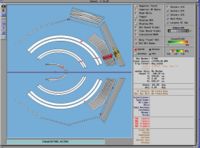
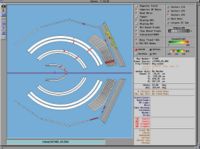
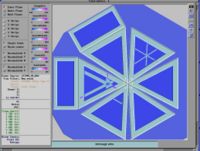
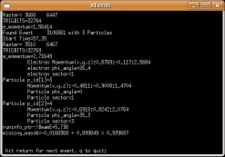
- [math]p_e = 5.736 Gev \sim E_e[/math] : electron mass is negligible
- [math]m_p = 0.938 GeV[/math] : Mass of a proton
- [math]m_n = 0.939566 GeV[/math] : Mass of a neutron
- [math]\beta_{cm} = \frac{5.736}{6.674} = 0.859 \lt 1[/math]
- [math]\gamma_{cm} = \frac{1}{\sqrt{1 - \beta_{cm}^2}} = \frac{1}{\sqrt{1 - 0.859^2}} = 1.9559[/math]
- [math]\left ( \begin{matrix} {E_e}^{\prime} \\ p_{ex}^{\prime} \\ p_{ey}^{\prime} \\ p_{ez}^{\prime} \end{matrix} \right )= \left [ \begin{matrix} \gamma_{cm} & 0 & 0 & -\gamma_{cm} \beta_{cm} \\ 0 & 1 &0 &0 \\ 0 &0 &1 &0 \\ -\gamma_{cm} \beta_{cm} &0 &0 &\gamma_{cm}\end{matrix} \right ] \left ( \begin{matrix} E_e=2.7165 \\ 0.8769 \\ -0.117 \\ 2.5684 \end{matrix} \right )[/math]
- [math]\left ( \begin{matrix} {E_n}^{\prime} \\ p_{nx}^{\prime} \\ p_{ny}^{\prime} \\ p_{nz}^{\prime} \end{matrix} \right )= \left [ \begin{matrix} \gamma_{cm} & 0 & 0 & -\gamma_{cm} \beta_{cm} \\ 0 & 1 &0 &0 \\ 0 &0 &1 &0 \\ -\gamma_{cm} \beta_{cm} &0 &0 & \gamma_{cm} \end{matrix} \right ] \left ( \begin{matrix} E_n =2.0218 \\ -0.4811 \\ -0.9008 \\ 1.4704 \end{matrix} \right )[/math]
- [math]\left ( \begin{matrix} {E_{\pi^+}}^{\prime} \\ p_{\pi^+ x}^{\prime} \\ p_{{\pi^+} y}^{\prime} \\ p_{{\pi^+} z}^{\prime} \end{matrix} \right )= \left [ \begin{matrix} \gamma_{cm} & 0 & 0 & -\gamma_{cm} \beta_{cm} \\ 0 & 1 &0 &0 \\ 0 &0 &1 &0 \\ -\gamma_{cm} \beta_{cm} &0 &0 & \gamma_{cm} \end{matrix} \right ] \left ( \begin{matrix} E_{\pi^+} =2.3431 \\ -0.6918 \\ 0.8242 \\ 2.0764 \end{matrix} \right )[/math]
- Electron
- [math]\left ( \begin{matrix} {E_e}^{\prime} \\ p_{ex}^{\prime} \\ p_{ey}^{\prime} \\ p_{ez}^{\prime} \end{matrix} \right )= \left ( \begin{matrix} 2.7165 \gamma_{cm} - 2.5684 \gamma_{cm} \beta_{cm} \\ 0.8769 \\ -0.117 \\ -2.7165\gamma_{cm} \beta_{cm} + 2.5684 \gamma_{cm} \end{matrix} \right ) = \left ( \begin{matrix} 0.99569 \\ 0.8769 \\ -0.117 \\ 0.45728 \end{matrix} \right )[/math]
- Neutron
- [math]\left ( \begin{matrix} {E_n}^{\prime} \\ p_{nx}^{\prime} \\ p_{ny}^{\prime} \\ p_{nz}^{\prime} \end{matrix} \right )= \left ( \begin{matrix} 2.0218\gamma_{cm} - 1.4704 \gamma_{cm} \beta_{cm} \\ -0.4811 \\ -0.9008 \\-2.0218 \gamma_{cm} \beta_{cm} + 1.4704\gamma_{cm} \end{matrix} \right ) = \left ( \begin{matrix} 1.4828 \\ -0.4811 \\ -0.9008 \\ -0.52256 \end{matrix} \right )[/math]
- [math]\pi^+[/math]
- [math]\left ( \begin{matrix} {E_{\pi^+}}^{\prime} \\ p_{\pi^+ x}^{\prime} \\ p_{{\pi^+} y}^{\prime} \\ p_{{\pi^+} z}^{\prime} \end{matrix} \right )= \left ( \begin{matrix} 2.3431\gamma_{cm} - 2.0764 \gamma_{cm} \beta_{cm} \\ -0.6918 \\ 0.8242 \\ -2.3431 \gamma_{cm} \beta_{cm} + 2.0764\gamma_{cm} \end{matrix} \right ) = \left ( \begin{matrix} 1.09257 \\ -0.6918 \\ 0.8242 \\ 0.1226 \end{matrix} \right )[/math]
[math]\vec {P_{tot}}^{\prime} = (p_{ex}^{\prime} + p_{nx}^{\prime} + p_{\pi^+x}^{\prime})\hat{x} + (p_{ey}^{\prime} + p_{ny}^{\prime} + p_{\pi^+y}^{\prime})\hat{y} + (p_{ez}^{\prime} + p_{nz}^{\prime} + p_{\pi^+z}^{\prime})\hat{z} = -0.296 \hat{x} + -0.1936 \hat{y} + 0.0573 \hat{z} [/math]
- Missing Mass Calculation
- Below is the conservation of the 4-momentum
[math](P_e)^\mu + (P_p)^\mu = ({P_e}^{\prime})^\mu + ({P_X}^{\prime})^\mu + ({P_{\pi^+}}^{\prime})^\mu[/math]
[math](P_e)_\mu + (P_p)_\mu = ({P_e}^{\prime})_\mu + ({P_X}^{\prime})_\mu + ({P_{\pi^+}}^{\prime})_\mu[/math]
- Solving it for the final neutron state
[math]{M_x}^2 = ({P_X}^{\prime})_\mu({P_X}^{\prime})^\mu = [(P_e)_\mu + (P_p)_\mu - ({P_e}^{\prime})_\mu - ({P_{\pi^+}}^{\prime})_\mu][(P_e)^\mu + (P_p)^\mu - ({P_e}^{\prime})^\mu - ({P_{\pi^+}}^{\prime})^\mu][/math]
- The 4-vectors for the particles in this event
[math](P_e)_\mu = ( 5.736, 0, 0, 5.736 GeV)[/math]
[math](P_p)_\mu = (m_p, 0, 0, 0)[/math]
[math]({P_e}^{\prime})_\mu = (2.7164, 0.8769, -0.117, 2.5684 )[/math]
[math]({P_{\pi^+}}^{\prime})_\mu = (2.3431, -0.6918, 0.8242, 2.0764)[/math]
[math]{M_x}^2 = [( 5.736, 0, 0, 5.736 GeV) + ( m_p, 0, 0, 0 ) - ( 2.7164, 0.8769, -0.117, 2.5684 ) - ( 2.3431, -0.6918, 0.8242, 2.0764 )[/math]] [[math]\left (\begin{matrix} 5.736 \\ 0 \\ 0 \\ 5.736 \end{matrix} \right )[/math] + [math]\left (\begin{matrix} m_p \\ 0 \\ 0 \\ 0 \end{matrix} \right) [/math] - [math]\left (\begin{matrix} 2.7164 \\ 0.8769 \\ -0.117 \\ 2.5684 \end{matrix} \right) [/math] - [math]\left ( \begin{matrix} 2.3431 \\ -0.6918 \\ 0.8242 \\ 2.0764\end{matrix} \right) ] = 0.882724889 GeV^2[/math]
[math]M_x = 0.9395344 GeV[/math]
[math]\phi_{diff}^{LAB} = \phi_e^{LAB} - \phi_{\pi^+}^{LAB} = (120 + 35.3) -26.4 = 128.9[/math]
[math]{\phi_{\pi}}^{CM}[/math] transformation from LAB frame to CM frame
Used file dst27095_05, event_number=3106861
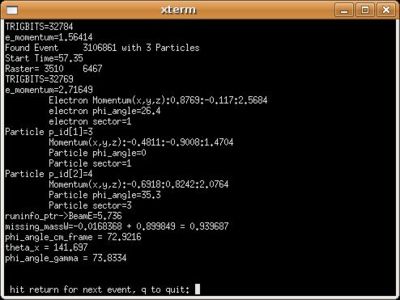
- [math]\beta_{cm} = \frac{5.736}{6.674} = 0.859 \lt 1[/math]
- [math]\gamma_{cm} = \frac{1}{\sqrt{1 - \beta_{cm}^2}} = \frac{1}{\sqrt{1 - 0.859^2}} = 1.9559[/math]
- [math]E_e = \sqrt{{p_e}^2 + {m_e}^2} = \sqrt{0.8769^2 + 0.117^2 + 2.56842^2} = 2.7165[/math]
- Calculation of [math]{{\phi}_{\gamma}}^{CM}[/math]
- [math]{\phi_{\gamma}}^{CM} = tan^{-1}(\frac{{p_{e z}}^{CM}}{{p_{e z}}^{ CM \prime}})[/math]
- [math]{p_{e z}}^{CM} = -\gamma_{CM} \beta_{CM}{p_{e z}}^{LAB} + \gamma_{CM} {p_{e z}}^{LAB} = [/math]
- [math] = -1.9559 \times 0.8594 \times 5.736 + 1.9559 \times 5.736 = 1.5773 [/math]
- [math]{p_{e z}}^{CM \prime} = -\gamma_{CM} \beta_{CM} E_e + \gamma_{CM} {p_{e z}}^{LAB \prime} = [/math]
- [math]= -1.9559 \times 0.8594 \times 2.7165 + 1.9559 \times 2.5684 = 0.4574 [/math]
- [math]\phi_{\gamma} = tan^{-1}(\frac{1.5773}{0.4574}) = 73.83 [/math]
- Calculation of [math]{\theta_x}^{CM}[/math]
- [math]{\theta_x}^{CM} = cos^{-1}(\frac{p_{e z}^{CM \prime} - {p_{e z}}^{CM}}{\sqrt{{p_{e x}^{CM \prime}}^2 + {p_{e y}^{CM \prime}}^2 + ({p_{e z}^{CM \prime} - {p_{e z}}^{CM}})^2}}) = [/math]
- [math] = cos^{-1}(\frac{0.4574 - 1.5773}{\sqrt{0.8769^2 + (-0.117)^2 + (0.4574 - 1.5773)^2}}) = 141.69 [/math]
- Calculation of [math]{\phi_{\pi}}^{CM}[/math]
- [math]E_{\pi} = \sqrt{{p_{\pi}}^2 + {m_{\pi}}^2} = [/math]
- [math] = \sqrt{(-0.6918)^2 + 0.8242^2 + 2.0764^2 + 0.13969^2} = 2.3428 [/math]
- [math]{p_{\pi z}}^{CM} = -\gamma_{CM} \beta_{CM} E_{\pi} + \gamma_{CM} {p_{\pi z}}^{LAB} = [/math]
- [math]= -1.9559 \times 0.8594 \times 2.3428 + 1.9559 \times 2.0764 = 0.1232 [/math]
- [math]{\phi}_{\pi}^{CM} = tan^{-1}(\frac{{p_{\pi y}}^{CM \prime}}{{p_{\pi x}}^{CM \prime}}) = [/math]
- [math] = tan^{-1}(\frac{-sin{{\phi}_{\gamma}} \times p_{\pi x}^{CM} + cos{{\phi}_{\gamma}} \times p_{\pi y}^{CM}}{sin{\theta_x}\times(cos{{\phi}_{\gamma}} \times p_{\pi x}^{CM} + sin{{\phi}_{\gamma}} \times p_{\pi y}^{CM}) + cos{\theta_x} \times p_{\pi z}^{CM}}) = [/math]
- [math] = tan^{-1}(\frac{-sin(73.83) \times (-0.6918) + cos(73.83) \times 0.8242}{sin(141.69)\times(cos(73.83) \times (-0.6918) + sin(73.83) \times 0.8242) + cos(141.69) \times 0.1232} = 72.92 [/math]
Missing_Mass(experimental data)
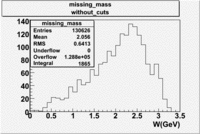
The mean value of the missing mass is around 2.056 GeV.
[math]\phi[/math] angle
[math]\phi[/math] angle for electrons and pions ([math]\pi^+[/math]) in lab frame [math]\phi_{e^-}^{LAB}[/math], [math]\phi_{\pi^+}^{LAB}[/math]
Used file is dst27095_05.B00.Target material is [math]NH_3[/math], Torus +2250 and beam energy 5.7 GeV
| For Electrons [math]e^-[/math] with cuts (e_p<3, [math]EC_{tot}\gt 0.2p[/math], [math]EC_{inner}\gt 0.08p[/math], nphe>2.5 and sc_paddle=7) |
For Pions([math]\pi^+[/math]) with cuts for sc_paddle=7
|
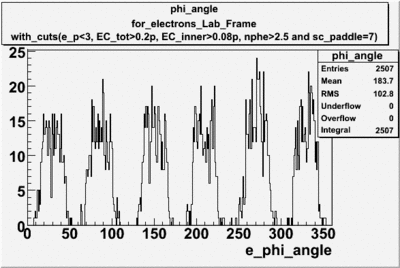
|
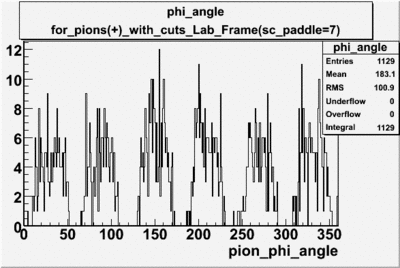
|
| For Electrons with cuts (e_p<3, [math]EC_{tot}\gt 0.2p[/math], [math]EC_{inner}\gt 0.08p[/math], nphe>2.5 and sc_paddle=7)
|
| SECTOR 1 |
SECTOR 2 |
SECTOR 3
|
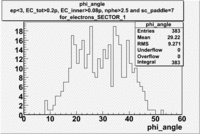
|
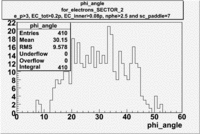
|
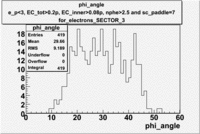
|
| SECTOR 4 |
SECTOR 5 |
SECTOR 6
|
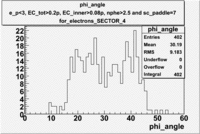
|
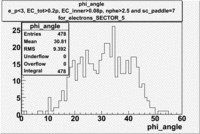
|
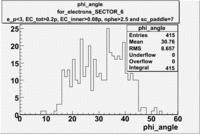
|
| For pions([math]\pi^+[/math]) with cuts for sc_paddle=7
|
| SECTOR 1 |
SECTOR 2 |
SECTOR 3
|
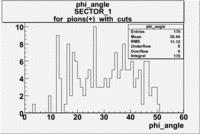
|
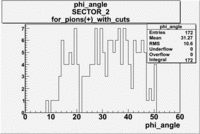
|
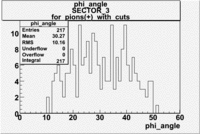
|
| SECTOR 4 |
SECTOR 5 |
SECTOR 6
|
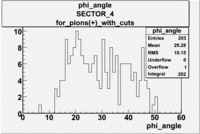
|
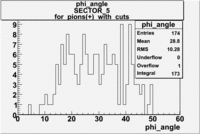
|
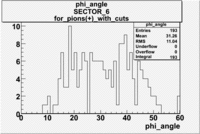
|
The plots below show what happens when you require the nphe from electron to be > 2.5 and you only look for pions in scintillator paddle 7.
Why is there a big gap for[math] \phi \lt 100[/math] ?
Take a look at theta -vs- phi plots for each sector. Do the dead spots impact difference?
Write equation for[math] \phi_{\pi}^{CM}[/math] in terms of Lab frame Momentum and energy.
Graph [math]\phi_{\pi}^{CM}[/math] for Pions hitting paddle #7. The y-axis should be pion counting rate in units of pions per nanCoulomb.
[math]\phi[/math] angle in the Center of Mass Frame
The variables below are in Lab Frame:
From [math]\vec{e}p \rightarrow n \pi^+[/math] from CLAS
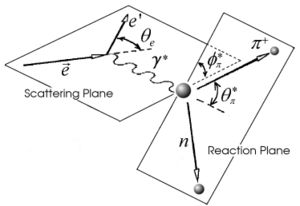 Kinematics of single [math]\pi^+[/math] electroproduction |
From the above picture we can write down the momentum x,y and z components for pion in terms of angle and total momentum.
[math]{p_{\pi x}}^{LAB} = p_{\pi}^{LAB} {sin {\theta}}_{\pi}^{LAB} cos {\phi}_{\pi}^{LAB}[/math]
[math]{p_{\pi y}}^{LAB} = p_{pi}^{LAB} {sin {\theta}}_{\pi}^{LAB} sin {\phi}_{\pi}^{LAB}[/math]
[math]{\phi}_{\pi}^{LAB} = arctg(\frac{{p_{\pi y}}^{LAB}}{{p_{\pi x}}^{LAB}})[/math]
where [math]{p_{\pi x}}^{LAB}[/math] and [math]{p_{\pi y}}^{LAB}[/math] are the x and y components of the pion momentum.
[math](P_e)^{\mu}[/math] - Initial electron 4-momentum
[math](P_N)^{\mu}[/math] - Target Nucleon 4-momentum
[math](P_e^{\prime})^{ \mu}[/math] - Scattered electron 4-momentum
[math](P_h)^{\mu}[/math] - Hadron final state 4-momentum
[math](P_m)^{\mu}[/math] - Meson final state 4-momentum
[math]h=n[/math], [math]m=\pi^+[/math] for [math]\vec{e} (\vec{p},\vec{e}^{\prime}) \pi^+ n[/math]
In Inclusive [math]\vec{e} (\vec{p},\vec{e}^{\prime}) X [/math]
Then The Missing Mass [math]W = (E_x ^2 - p_x ^2)[/math]
In Exclusive [math]\vec{e} (\vec{p},\vec{e}^{\prime}) \pi^+ X[/math]
Then Missing Mass [math] M = (E_h ^2 - p_h ^2)[/math]
Conservation of 4-momentum gives
[math](P_e)^\mu + (P_N)^\mu = ({P_e}^{\prime})^\mu + {P_h}^\mu + ({P_m})^\mu[/math]
[math]{P_h}^\mu = (P_e)^\mu - ({P_e}^{\prime})^\mu + (P_N)^\mu -({P_m})^\mu[/math]
[math]q^\mu[/math] - 4-momentum of the exchanged virtual photon([math]\gamma[/math])
[math]q^\mu = (P_e^{\prime})^\mu - P_e ^{\mu} = (E_e ^{\prime}, {\vec{p}_e} ^{\prime}) - (E_e, {\vec{p}_e}) = [/math]
[math] = (E_e ^{\prime} - E_e,{\vec{p}_e} ^{\prime} - {\vec{p}_e} ) = (0,{\vec{p}_e} ^{\prime} - {\vec{p}_e}) = (0, p_{e,x}^{\prime}\hat{x} + p_{e,y}^{\prime}\hat{y} + (p_{e,z}^{\prime} - p_{e,z})\hat{z})[/math]
[math]\phi_{\gamma} = tan^{-1}(\frac{p_{e x}^{\prime}}{p_{e z}^{\prime}})[/math]
[math]\theta_x = cos^{-1}(\frac{p_{e z}^{\prime} - p_{e z}}{\sqrt{{p_{e x}^{\prime}}^2 + {p_{e y}^{\prime}}^2 + ({p_{e z}^{\prime} - p_{e z}})^2}})[/math]
[math]p_{e x}^{\prime} = p_{e x}^{\prime CM}[/math]
[math]p_{e y}^{\prime} = p_{e y}^{\prime CM}[/math]
[math]p_{e z}^{\prime CM} = -E_e \gamma_{CM} \beta_{CM} + p_{e z }^{\prime LAB} \gamma_{CM}[/math]
[math]p_{e z}^{CM} = -p_{e z}^{LAB} \gamma_{CM} \beta_{CM} + p_{e z}^{LAB} \gamma_{CM}[/math]
[math]p_{e z}^{LAB} = Beam Energy [/math]
First the coordinate system is rotated around z-axis by [math]\phi_{\gamma}[/math] angle and then around y-axis by [math]\theta_x[/math] angle. Below is presented the transformation matrix.
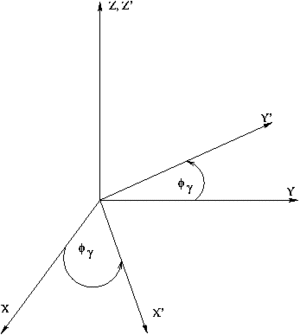
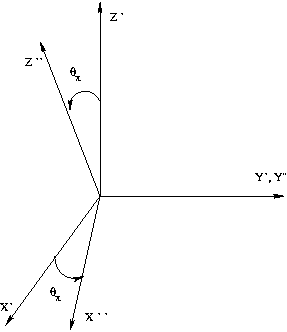
[math]\left ( \begin{matrix} p_{\pi x}^{LAB{\prime}} \\ p_{\pi y}^{LAB{\prime}} \\p_{\pi z}^{LAB{\prime}} \end{matrix} \right )= \left [ \begin{matrix} cos {\theta}_x & 0 & -sin {\theta_x} \\ 0 & 1 &0 \\ sin {\theta_x} &0 & cos {\theta_x} \end{matrix} \right ] \left [ \begin{matrix} cos {\phi_{\gamma}} & sin {\phi_{\gamma}} & 0 \\ -sin {\phi_{\gamma}} & cos {\phi_{\gamma}} &0 \\ 0 &0 & 1 \end{matrix} \right ] \left ( \begin{matrix} p_{\pi x}^{LAB} \\p_{\pi y}^{LAB} \\ p_{\pi z}^{LAB} \end{matrix} \right ) = [/math]
[math]= \left ( \begin{matrix} cos {\theta}_x (cos {\phi_{\gamma}} p_{\pi x}^{LAB} + sin {\phi_{\gamma}} p_{\pi y}^{LAB}) - sin {\theta}_x p_{\pi z}^{LAB} \\ -sin {\phi_{\gamma}} p_{\pi x}^{LAB} + cos {\phi_{\gamma}} p_{\pi y}^{LAB} \\ sin {\theta}_x (cos {\phi_{\gamma}} p_{\pi x}^{LAB} + sin {\phi_{\gamma}} p_{\pi y}^{LAB}) + cos {\theta}_x p_{\pi z}^{LAB} \end{matrix} \right ) [/math]
[math]{\phi}_{\pi}^{LAB{\prime}} = tan^{-1}(\frac{{p_{\pi y}}^{LAB{\prime}}}{{p_{\pi x}}^{LAB{\prime}}}) = tan^{-1}(\frac{-sin{\phi_{\gamma}} \times p_{\pi x}^{LAB} + cos{\phi_{\gamma}} \times p_{\pi y}^{LAB}}{sin{\theta_x}\times(cos{\phi_{\gamma}} \times p_{\pi x}^{LAB} + sin{\phi_{\gamma}} \times p_{\pi y}^{LAB}) + cos{\theta_x} \times p_{\pi z}^{LAB}})[/math]
[math]{\phi}_{\pi}^{CM} = tan^{-1}(\frac{{p_{\pi y}}^{CM}}{{p_{\pi x}}^{CM}}) = tan^{-1}(\frac{-sin{\phi_{\gamma}} \times p_{\pi x}^{CM} + cos{\phi_{\gamma}} \times p_{\pi y}^{CM}}{sin{\theta_x}\times(cos{\phi_{\gamma}} \times p_{\pi x}^{CM} + sin{\phi_{\gamma}} \times p_{\pi y}^{CM}) + cos{\theta_x} \times p_{\pi z}^{CM}})[/math]
[math]p_{\pi x}^{CM} = p_{\pi x}^{LAB}[/math]
[math]p_{\pi y}^{CM} = p_{\pi y}^{LAB}[/math]
[math]p_{\pi z}^{CM} = -E_{\pi} \gamma_{CM} \beta_{CM} + p_{\pi z}^{LAB} \gamma_{CM}[/math]
= Phi rate =
Why does the [math]\phi[/math] angle only go out to 80 degrees?
Add FC histogram, Add plot from paper, start calculating cross -section, Find luminosity of NH3 target used
The rotation matrix, that rotates the coordinate system around y axis by [math]\theta_x[/math] angle is given
[math]\left ( \begin{matrix} p_{\pi x}^{LAB{\prime}} \\ p_{\pi y}^{LAB{\prime}} \\p_{\pi z}^{LAB{\prime}} \end{matrix} \right )= \left [ \begin{matrix} cos {\theta}_x & 0 & sin {\theta_x} \\ 0 & 1 &0 \\ -sin {\theta_x} &0 & cos {\theta_x} \end{matrix} \right ] \left ( \begin{matrix} p_{\pi x}^{LAB} \\p_{\pi y}^{LAB} \\ p_{\pi z}^{LAB} \end{matrix} \right )[/math]
Now, the x, y and z components of the momentum can be written in terms of the momentums of the rotated system.
[math]p_{\pi x}^{LAB {\prime}} = cos {\theta}_x \times p_{\pi x}^{LAB} + sin {\theta_x} \times p_{\pi z}^{LAB}[/math]
[math]p_{\pi y}^{LAB{\prime}} = p_{\pi y}^{LAB}[/math]
[math]p_{\pi z}^{LAB{\prime}} = -sin {\theta}_x \times p_{\pi x}^{LAB} + cos {\theta_x} \times p_{\pi z}^{LAB}[/math]
[math]{\phi}_{\pi}^{LAB} = arctg(\frac{p_{\pi y}^{LAB}}{cos {\theta}_x \times p_{\pi x}^{LAB} + sin {\theta_x} \times p_{\pi z}^{LAB}})[/math]
[math]{\phi}_{\pi}^{CM} = tan^{-1}(\frac{p_{\pi y}^{LAB}}{cos {\theta}_x \times p_{\pi x}^{LAB} + sin {\theta_x} \times (- \gamma_{CM} \beta_{CM} E_{\pi}^{LAB} + \gamma_{CM} p_{\pi z}^{LAB})})[/math]
where [math]\theta_x[/math] is the angle between the photon and the electron. The angle can be found using the conservation of momentum and energy.
Conservation of Momentum [math]\Rightarrow[/math] :
[math]\vec{p}_e = \vec{p}_{e^{\prime}} + \vec{p}_{\gamma}[/math] [math]\Rightarrow[/math] [math]\vec{p}_{e^{\prime}} = \vec{p}_e - \vec{p}_{\gamma}[/math]
[math]{p_{e^{\prime}}}^2 = {p_e}^2 - 2 p_e p_{\gamma}cos {\theta_x} + {p_{\gamma}}^2[/math]
[math]cos {\theta_x} = \frac {{p_e}^2 + {p_{\gamma}}^2 - {p_{e^{\prime}}}^2}{2 p_e p_{\gamma}}[/math]
Conservation of Energy [math]\Rightarrow[/math] :
[math] E_e = E_{e^{\prime}} + E_{\gamma}[/math]
[math]\sqrt {(m_e c^2)^2 + (p_e c)^2} = \sqrt {(m_e c^2)^2 + (p_{e^{\prime}} c)^2} + p_{\gamma} c[/math]
[math]p_{\gamma} c = \sqrt {(m_e c^2)^2 + (p_e c)^2} - \sqrt {(m_e c^2)^2 + (p_{e^{\prime}} c)^2}[/math]
[math]p_{\gamma} = \sqrt {(m_e)^2 + (p_e)^2} - \sqrt {(m_e)^2 + (p_{e^{\prime}})^2}[/math]
The [math]cos {\theta_x}[/math] can be written in the following way
[math]cos {\theta_x} = \frac {{p_e}^2 + ( \sqrt {(m_e)^2 + (p_e)^2} - \sqrt {(m_e)^2 + (p_{e^{\prime}})^2})^2 - {p_{e^{\prime}}}^2}{2 p_e ( \sqrt {(m_e)^2 + (p_e)^2} - \sqrt {(m_e)^2 + (p_{e^{\prime}})^2}) }[/math]
angle is in degrees
Pion Rates -vs- Paddle for opposite sign Torus fields
- using all events in which the first particle (the one which caused the trigger) is defined as an electrons and passes the
above electron cuts.
sc_paddle vs X_bjorken 5.7 GeV Beam Energy
| no cuts |
cuts |
no cuts |
cuts
|
| Electrons |
B > 0 |
|
B<0
|
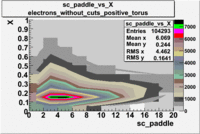
|
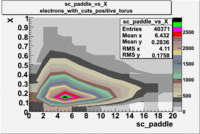
|
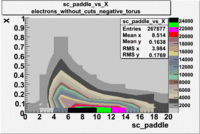
|
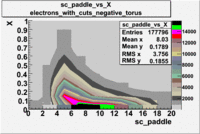
|
| [math]\pi^-[/math] |
B > 0 |
|
B<0
|
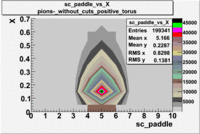
|
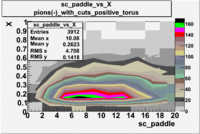
|
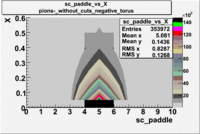
|
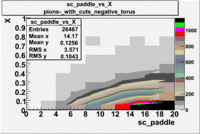
|
| [math]\pi^+[/math] |
B > 0 |
|
B<0
|
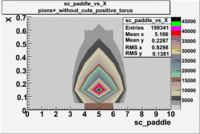
|
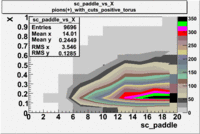
|
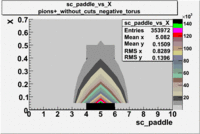
|
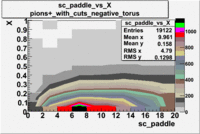
|
sc_paddle vs X_bjorken with cuts 5.7 GeV Beam Energy(number of events=2)
| [math]\pi^-[/math] |
[math]\pi^-[/math]
|
| B>0 |
B<0
|
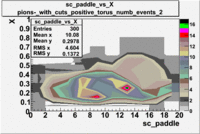
|
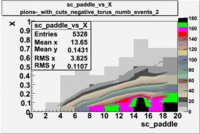
|
| [math]\pi^+[/math] |
[math]\pi^+[/math]
|
| B>0 |
B<0
|
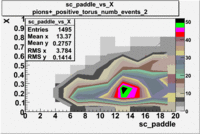
|
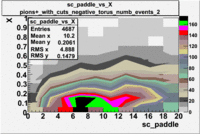
|
sc_paddle vs Momentum 5.7 GeV Beam Energy
There is a curvature problem. When B > 0 then I expect the high momentum electrons to hit the lower
paddle numbers (inbending). I can see this when I look at the B>0 plot for electrons with cuts.
When B < 0 then the electrons are bending outwards which makes me expect the the higher momentum
electrons will high the higher numbered paddles. I do not see this for B>0 with electron cuts.
| no cuts |
cuts |
no cuts |
cuts
|
| Electons |
B > 0 |
|
B<0
|
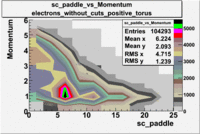
|
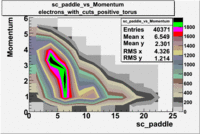
|
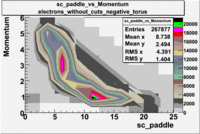
|
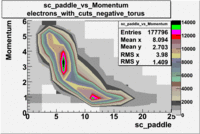
|
| [math]\pi^-[/math] |
B > 0 |
|
B<0
|
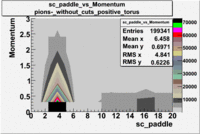
|
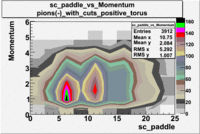
|
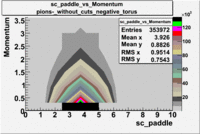
|
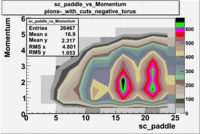
|
| [math]\pi^+[/math] |
B > 0 |
|
B<0
|
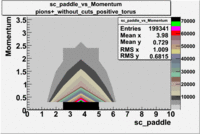
|
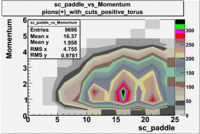
|
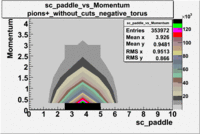
|
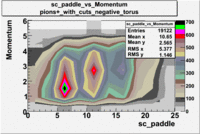
|
sc_paddle vs Momentum with cuts 5.7 GeV Beam Energy(number of events=2)
| [math]\pi^-[/math] |
[math]\pi^-[/math]
|
| B>0 |
B<0
|
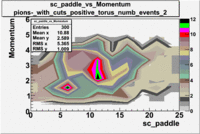
|
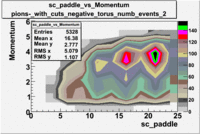
|
| [math]\pi^+[/math] |
[math]\pi^+[/math]
|
| B>0 |
B<0
|
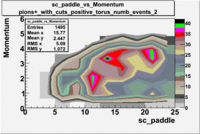
|
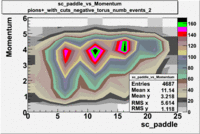
|
Used file dst26988_05.B00(Energy=5.7GeV and Torus=-2250)
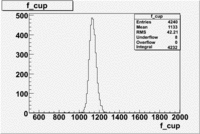
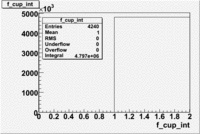
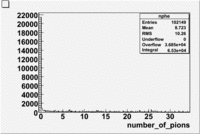
Paddle 7 Rates and statistics
The number of events per trigger is measured for the respective DST file above and then the Total number events in the data set is estimated from that.
| [math]X_{bj}[/math] |
[math]\pi^-[/math](B>0) |
|
[math]\pi^+[/math](B<0) |
|
|
Total Number Events [math](10^{3})[/math] |
Number events per [math]10^6[/math] triggers |
Total Number Events [math](10^{3})[/math] |
Number events per [math]10^6[/math] trigger
|
| 0.1 |
5.1 |
71 |
24.6 |
547
|
| 0.2 |
6.9 |
96 |
13.7 |
305
|
| 0.3 |
3.7 |
51 |
6.2 |
137
|
| 0.4 |
3.3 |
45 |
2.7 |
60
|
| 0.5 |
0.9 |
13 |
0.99 |
22
|
Paddle 17 Rates and statistics
| [math]X_{bj}[/math] |
[math]\pi^-[/math](B<0) |
|
[math]\pi^+[/math](B>0) |
|
|
Total Number Events [math](10^{3})[/math] |
Number events per [math]10^{6}[/math] trigger |
Total Number Events [math](10^{3})[/math] |
Number events per [math]10^{6}[/math] trigger
|
| 0.1 |
6.2 |
137 |
4.6 |
64
|
| 0.2 |
3.5 |
79 |
4.9 |
67
|
| 0.3 |
1.7 |
39 |
2.6 |
36
|
| 0.4 |
0.3 |
7 |
2.1 |
29
|
| 0.5 |
0.1 |
2 |
0.6 |
8
|
Paddle 5 and 8 Rates and statistics for electrons
| [math]X_{bj}[/math] |
[math]e^-[/math] sc_paddle=5 (B>0) |
|
[math]e^-[/math] sc_paddle=8 (B<0) |
|
|
Total Number Events [math](10^{3})[/math] |
Number events per [math]10^{6}[/math] trigger [math](10^{3})[/math] |
Total Number Events [math](10^{3})[/math] |
Number events per [math]10^{6}[/math] trigger [math](10^{4})[/math]
|
| 0.1 |
384.9 |
5.314 |
1665.2 |
3.706
|
| 0.2 |
382.5 |
5.282 |
977.8 |
2.176
|
| 0.3 |
264.9 |
3.657 |
567.1 |
1.262
|
| 0.4 |
159.5 |
2.202 |
328.6 |
0.7313
|
| 0.5 |
99 |
1.367 |
218.2 |
0.4856
|
Histograms for 5.7 GeV Beam Energy
| Electron energy/momentum |
Electron Theta ([math]\theta[/math]) |
Electron Qsqrd |
Electron X_bjorken
|
| B>0 and sc_paddle=5 |
|
|
|
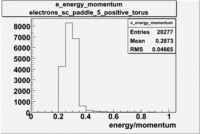
|
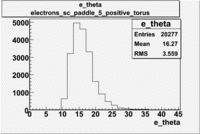
|
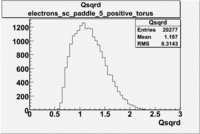
|
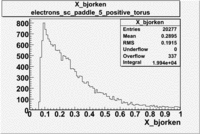
|
| B<0 and sc_paddle=8 |
|
|
|
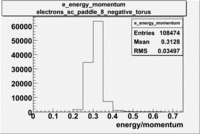
|
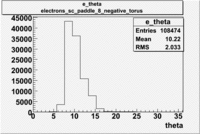
|
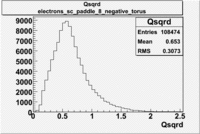
|
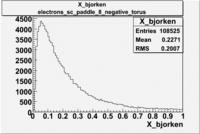
|
Normalized X_bjorken for electrons
| B>0 and sc_paddle=5 |
B<0 and sc_paddle=8
|
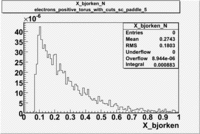
|
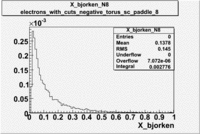
|
Asymmetries
Systematic Errors
Media:SebastianSysErrIncl.pdf Sebastian's Writeup














